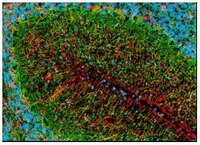NE1015 Sigma-AldrichAnti-Glial Fibrillary Acidic Protein Cocktail Mouse mAb (SMI-22)
This Anti-Glial Fibrillary Acidic Protein Cocktail Mouse mAb is validated for use in ELISA, Frozen Sections, WB, ICC, Paraffin Sections for the detection of Glial Fibrillary Acidic Protein.
More>> This Anti-Glial Fibrillary Acidic Protein Cocktail Mouse mAb is validated for use in ELISA, Frozen Sections, WB, ICC, Paraffin Sections for the detection of Glial Fibrillary Acidic Protein. Less<<Synonyms: Anti-GFAP Cocktail
Recommended Products
개요
| Replacement Information |
|---|
주요 사양표
| Species Reactivity | Host | Antibody Type |
|---|---|---|
| B, Ca, Ch, Gp, H, M, Porcine, R, Sh | M | Monoclonal Antibody |
가격 및 재고여부
| 카탈로그 번호 | 재고 정보 | 패킹 | 포장 단위 | 가격(VAT 별도) | 수량 | |
|---|---|---|---|---|---|---|
| NE1015-100ULCN |
|
Plastic ampoule | 100 ul |
|
— |
| References | |
|---|---|
| References | Vick, W.W., et al. 1987. Acta. Cytol. 31, 816. McLendon R.E., et al. 1986. J. Neuropathol. Exp. Neurol. 45, 692. Pegram, C.N., et al. 1985. Neurochem. Pathol. 3, 119. |
| Product Information | |
|---|---|
| Form | Liquid |
| Formulation | Undiluted ascites. |
| Positive control | Astrocytes or cytoskeletal preparations |
| Preservative | ≤ 0.1% sodium azide |
| Quality Level | MQ100 |
| Physicochemical Information |
|---|
| Dimensions |
|---|
| Materials Information |
|---|
| Toxicological Information |
|---|
| Safety Information according to GHS |
|---|
| Safety Information |
|---|
| Product Usage Statements |
|---|
| Packaging Information |
|---|
| Transport Information |
|---|
| Supplemental Information |
|---|
| Specifications |
|---|
| Global Trade Item Number | |
|---|---|
| 카탈로그 번호 | GTIN |
| NE1015-100ULCN | 04055977209853 |
Documentation
Anti-Glial Fibrillary Acidic Protein Cocktail Mouse mAb (SMI-22) MSDS
| 타이틀 |
|---|
Anti-Glial Fibrillary Acidic Protein Cocktail Mouse mAb (SMI-22) Certificates of Analysis
| Title | Lot Number |
|---|---|
| NE1015 |
References
| 참고문헌 보기 |
|---|
| Vick, W.W., et al. 1987. Acta. Cytol. 31, 816. McLendon R.E., et al. 1986. J. Neuropathol. Exp. Neurol. 45, 692. Pegram, C.N., et al. 1985. Neurochem. Pathol. 3, 119. |









